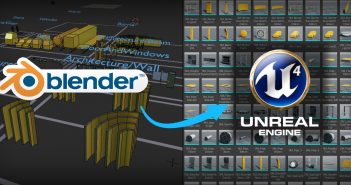Blender artist Cédric Bonacina talks about his background as a 3D artist and his experiences with selling on the Sketchfab Store.
Hi, my name is Cédric Bonacina (Kyan0s) and I’m a Belfort (France) based 3D artist who is mainly focused on the creation of biological models like characters or animals, doing modeling, sculpting, texturing, rigging, animation, etc. These are domains that I learned by myself a few years ago by reading tutorials, magazines, etc. One day I discovered 3D and its many possibilities, and from then on I did not cease to create my worlds and my characters in my free time. What I especially like is being able to create long gone prehistoric creatures and give them life through movement. I was a huge fan of the movie Jurassic Park as a child, and as a result I wanted to make my own creatures.





6 Comments
I always love prehistory. I've just got started practicing making my own 3D dinosaurs with more or less the same inspiration Kyan0s had. Nice to see him on the spotlight.
Bravo! What fun. Thank you for showing this!
Would love to know how you got such fluid muscle movement. Would you do a tutorial on your process? Great work.
Thank you ! :)
Well, I do not really have any particular advices except practice and time. To have a good rigging and a good muscle movement, first I rarely use the automatic rigging, I take a lot of time to manually spread the bone weight to the mesh, for example, in the chest region of the creature I try to correctly associate vertice by vertice to the chest bones, the shoulder bone and the spine bone close to the chest bone. The spine will have an little influence to the vertices at the base of the shoulder bone, as well as the bone of the chest.
Another example, for the vertices of the spine, I try to manually add the influence of the chest or the pelvis. The vertice that are at the junction of the chest and the spine will recieve 0.5 of the chest bone and the spine bone. The next group of spine vertices will recieve 0.75 of the spine bone and 0.25 of the chest bone, and so on. I do the same in the other side with the plevis bone. If a vertice must have the influence of several bone I try to calculate the value.
A long comment not really clear :S but I hope that it will still help you. I might try one day to do a tutorial, or a workshop on the process of rigging and animation. :)
In the meantime here is a workshop of my liopleurodon where I detail a little my work : https://blog.sketchfab.com/art-spotlight-liopleurodon-ferox/ .
Thank you for your very generous reply. I appreciate the time taken on your part. I will read your blog link. I was mostly curious about the residual motion of muscle and fat within the animation. It is similar to the effects generated by a program called Ziva. Did you manually create those motions yourself via keyframes?
Thank you again. I have quite a ways to go with Blender. I am a 70-year old retire illustrator who has dabbled in 3D since my Amiga days but never really had time to devote to learn it in depth. Hopefully, that will change now.
Very much appreciated your reply.
You're welcome ! :)
Yes, I create all my animations by keyframes.